Models in information behaviour research
T.D. Wilson, PhD
Department of Information Studies
University of Sheffield
Presents an outline of models of information seeking and other aspects of information behaviour, showing the relationship between communication and information behaviour in general with information seeking and information searching in information retrieval systems. It is suggested that these models address issues at various levels of information behaviour and that they can be related by envisaging a 'nesting' of models. It is also suggested that, within both information seeking research and information searching research, alternative models address similar issues in related ways and that the models are complementary rather than conflicting. Finally, an alternative, problem-solving model is presented, which, it is suggested, provides a basis for relating the models in appropriate research strategies.
1. Introduction
The aim of this paper is to review the status of models of information behaviour to discover how they may relate one to another and, perhaps, propose an integration of the models into a more general framework. To this end, this paper offers a view of the existing research as a set of 'nested' models bound together by a dependency upon one another and by an increasing concern, as we move to deeper levels, with finer and finer details of human information seeking and searching behaviour. By information behaviour is meant those activities a person may engage in when identifying their own needs for information, searching for such information in any way, and using or transferring that information.
Research in information behaviour has occupied information scientists, since before the term information science was coined. We can take its origins back to the Royal Society Scientific Information Conference of 1948[1], when a number of papers on the information behaviour of scientists and technologists were presented. Of course, the term information behaviour was not used in the papers, which were generally about document and library use, but the origins are clearly there. This was seven years before Hanson (of Aslib) coined the term information science and nine years before the establishment of the Institute of Information Scientists in the U.K. the first professional society devoted to the field.
Over the intervening period since the Royal Society conference literally thousands of papers and research reports have been produced on user needs, information needs, and information-seeking behaviour (see, for example:[2-6]). Throughout the period the one constant complaint of commentators has been that researchers have not built upon prior research in such a way as to cumulate a body of theory and empirical findings that may serve as a starting point for further research.
A number of reasons can be advanced for this situation: first, in the positivist tradition, quantitative research methods were adopted that were inappropriate to the study of human behaviour. Many things were counted, from the number of visits to libraries, to the number of personal subscriptions to journals and the number of items cited in papers. Very little of this counting revealed insights of value for the development of theory or, indeed, of practice. Secondly, researchers in the field of information science seem generally to have ignored allied work in related areas that might offer more robust theoretical models of human behaviour (see Wilson [7] for a review of such research). Thirdly, general models of information behaviour have only begun to emerge, and attract much attention, in the past ten to fifteen years.
The situation is now changing (as Wilson has suggested [3]). The general adoption of qualitative methods (from the early 1970s in the UK) has resulted in work that is in the wider tradition of the investigation of human behaviour and which, therefore, is more likely to find theories and models in the social sciences that can be applied to the study of information behaviour. At the same time, the models and theories proposed by certain researchers (e.g. Dervin, Ellis, Kuhlthau, Wilson), have gained strength as they have been adopted as the basis for further research by other investigators.
2. A model of information behaviour
A model may be described as a framework for thinking about a problem and may evolve into a statement of the relationships among theoretical propositions. Most models in the general field of information behaviour are of the former variety: they are statements, often in the form of diagrams, that attempt to describe an information-seeking activity, the causes and consequences of that activity, or the relationships among stages in information-seeking behaviour. Rarely do such models advance to the stage of specifying relationships among theoretical propositions: rather, they are at a pre-theoretical stage, but may suggest relationships that might be fruitful to explore or test.
Models of information behaviour, however, appear to be fewer than those devoted to information-seeking behaviour or information searching. Figure 1 is a variation on my own model of 1981[8]:

The aim of this model was to outline the various areas covered by what the writer proposed as information-seeking behaviour, as an alternative to the then common information needs, but it is clear that the scope of the diagram is much greater and that it attempts to cover most of what is included here as information behaviour.
The model suggests that information-seeking behaviour arises as a consequence of a need perceived by an information user, who, in order to satisfy that need, makes demands upon formal or informal information sources or services, which result in success or failure to find relevant information. If successful, the individual then makes use of the information found and may either fully or partially satisfy the perceived need - or, indeed, fail to satisfy the need and have to reiterate the search process. The model also shows that part of the information-seeking behaviour may involve other people through information exchange and that information perceived as useful may be passed to other people, as well as being used (or instead of being used) by the person himself or herself.
One of the results of the analysis that led to the diagram was the recognition that information use had received little attention and, within information science, that statement is still relatively true today. Nor has much attention been devoted to the phenomenon of the informal transfer of information between individuals since Allen's pioneering work[9] on transferring to the research laboratory the 'two-step' flow of communication model of the 'gatekeeper'. The identification of these areas as relatively lacking in research attention demonstrates one of the functions of these models.
The limitation of this kind of model, however, is that it does little more than provide a map of the area and draw attention to gaps in research: it provides no suggestion of causative factors in information behaviour and, consequently, it does not directly suggest hypotheses to be tested.
3. Models of information-seeking behaviour
When we turn to information-seeking behaviour the models are rather more numerous: five will be discussed here: Wilson's (1981) model of information-seeking behaviour[8]; Dervin's (1983) sense-making theory[10]; Ellis's (1989 and 1993) behavioural model of information seeking strategies[11, 12]; Kuhlthau's (1991) model of the stages of information-seeking behaviour [13]; and Wilson's (1996) model [2, 7], which expands his 1981 model through an analysis of the literature in fields other than information science.
3.1 Wilson, 1981
Wilson's second model of 1981 is based upon two main propositions: first, that information need is not a primary need, but a secondary need that arises out of needs of a more basic kind; and second, that in the effort to discover information to satisfy a need, the enquirer is likely to meet with barriers of different kinds. Drawing upon definitions in psychology[14], Wilson proposes that the basic needs can be defined as physiological, cognitive or affective. He goes on to note that the context of any one of these needs may be the person him- or herself, or the role demands of the person's work or life, or the environments (political, economic, technological, etc.) within which that life or work takes place. He then suggests that the barriers that impede the search for information will arise out of the same set of contexts.
This model is shown in a simplified version (which also shows the search behaviours defined by Ellis[11] in Figure 2, below. Wilson's model is clearly what may be described as a macro-model or a model of the gross information-seeking behaviour and it suggests how information needs arise and what may prevent (and, by implication, aid) the actual search for information. It also embodies, implicitly, a set of hypotheses about information behaviour that are testable: for example, the proposition that information needs in different work roles will be different, or that personal traits may inhibit or assist information seeking. Thus, the model can be regarded as a source of hypotheses, which is a general function of models of this kind.
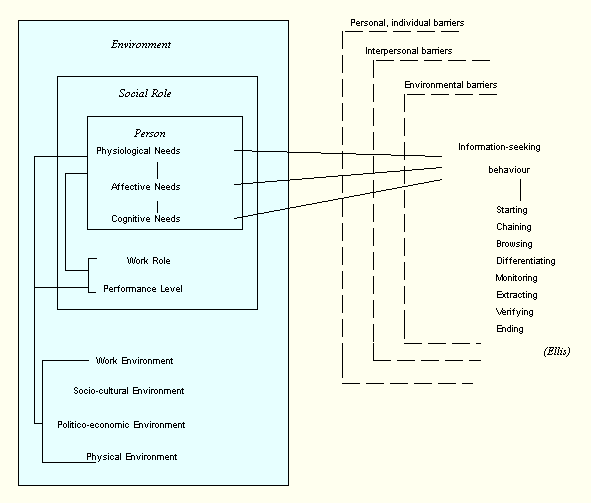
The weakness of the model is that all of the hypotheses are only implicit and are not made explicit. Nor is there any indication of the processes whereby context has its effect upon the person, nor of the factors that result in the perception of barriers, nor of whether the various assumed barriers have similar or different effects upon the motivation of individuals to seek information. However, the very fact that the model is lacking in certain elements stimulates thinking about the kinds of elements that a more complete model ought to include.
3.2 Dervin, 1983, 1996
Dervin's sense-making theory has developed over a number of years, and cannot be seen simply as a model of information-seeking behaviour: it is, rather, as she says[10], '…a set of assumptions, a theoretic perspective, a methodological approach, a set of research methods, and a practice.' designed to cope with information perceived as, '…a human tool designed for making sense of a reality assumed to be both chaotic and orderly.'
However, sense-making is implemented in terms of four constituent elements - a situation in time and space, which defines the context in which information problems arise; a gap, which identifies the difference between the contextual situation and the desired situation (e.g. uncertainty); an outcome, that is, the consequences of the sense-making process, and a bridge, that is, some means of closing the gap between situation and outcome. Dervin presents these elements in terms of a triangle: situation, gap/bridge, and outcome, which can be represented as in figure 3:

However, it may be preferable to use the bridge metaphor more directly and present the model as figure 4 below:
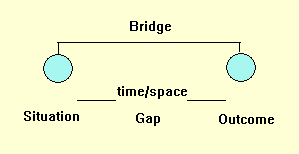
The strength of Dervin's model lies partly in its methodological consequences, since, in relation to information behaviour, it can lead to a way of questioning that can reveal the nature of a problematic situation, the extent to which information serves to bridge the gap of uncertainty, confusion, or whatever, and the nature of the outcomes from the use of information. Applied consistently in 'micro-moment, time-line interviews' such questioning leads to genuine insights that can influence information service design and delivery (e.g., [15, 16]).
3.3 Ellis, 1989 and Ellis, Cox & Hall, 1993
Ellis's elaboration of the different behaviours involved in information seeking is not set out as a diagrammatic model and Ellis makes no claims to the effect that the different behaviours constitute a single set of stages; indeed, he uses the term 'features' rather than 'stages'. These features are named and defined below:
- Starting: the means employed by the user to begin seeking information, for example, asking some knowledgeable colleague;
- Chaining: following footnotes and citations in known material or 'forward' chaining from known items through citation indexes;
- Browsing: 'semi-directed or semi-structured searching' (Ellis, 1989: 187)
- Differentiating: using known differences in information sources as a way of filtering the amount of information obtained;
- Monitoring: keeping up-to-date or current awareness searching;
- Extracting: selectively identifying relevant material in an information source;
- Verifying: checking the accuracy of information;
- Ending: which may be defined as 'tying up loose ends' through a final search.
The strength of Ellis's model as with Kuhlthau's, is that it is based on empirical research and has been tested in subsequent studies, most recently in the context of an engineering company [17].
Of the features, Ellis notes that, '...the detailed interrelation or interaction of the features in any individual information seeking pattern will depend on the unique circumstances of the information seeking activities of the person concerned at that particular point in time' ([11, p.178]). However, it is clear that Starting must initiate a process and that Ending must end it. It also seems reasonable to suggest that Verifying is a penultimate stage in a process and that Extracting must follow on from specific search behaviour such as Browsing. Indeed, drawing attention to this fact, leads to the conclusion that Extracting is not an information behaviour of the same kind as Browsing, or Chaining or Monitoring. It further suggests that Differentiating is also a different kind of behaviour: browsing, chaining and monitoring are search procedures, whereas differentiating is a filtering process and extracting may be seen as an action performed on the information sources
The remaining behaviours do not necessarily take place in a specific sequence and may be initiated in different sequences at different times in the overall search process. Ellis's account, therefore, in terms of the different kinds of features it embodies, appears to sit between the micro-analysis of search behaviour (starting, chaining, extracting, verifying, ending) and a more macro-analysis of information behaviour generally (browsing, monitoring, differentiating).
If these points are accepted, it is then possible to suggest a diagrammatic presentation of the model, as in Figure 5:

Thus, the models of Wilson and of Ellis are intended to function at different levels of the overall process of information seeking and this fact is demonstrated by the ability to nest one within the other.
3.4 Kuhlthau, 1991
Kuhlthau's work[13, 18] complements that of Ellis by attaching to stages of the 'information search process' the associated feelings, thoughts and actions, and the appropriate information tasks. This association of feelings, thoughts and actions clearly identify Kuhlthau's perspective as phenomenological, rather than cognitive. The stages of Kuhlthau's model are Initiation, Selection, Exploration, Formulation, Collection and Presentation. As an example, the Initiation phase of the process is said to be characterized by feelings of uncertainty, vague and general thoughts about the problem area, and is associated with seeking background information: the 'appropriate task' at this point is simply to 'recognize' a need for information. The remaining appropriate tasks are: Identify - that is, fix the general topic of the search; Investigate, or search for information on that general topic; Formulate - focus on a more specific area with in the topic; Collection, that is, gather relevant information on the focus; and Complete - end the information search.
Kuhlthau's model is thus more general than that of Ellis in drawing attention to the feelings associated with the various stages and activities. In this regard, Kuhlthau acknowledges her debt to Kelly's personal construct theory, ([19]) which '...describes the affective experience of individuals involved in the process of constructing meaning from the information they encounter.' ([20, p.364]). The fundamental proposition is that the feelings of uncertainty associated with the need to search for information give rise to feelings of doubt, confusion and frustration and that, as the search process proceeds and is increasingly successful, those feelings change: as relevant material is collected confidence increases and is associated with feelings of relief, satisfaction and a sense of direction.
In effect, what Kuhlthau postulates here (and confirms by empirical research) is a process of the gradual refinement of the problem area, with information searching of one kind or another going on while that refinement takes place. Thus, a successive search process is implicit in Kuhlthau's analysis of the search activity. Although Kuhlthau's early work was a series of longitudinal studies of high school students, more recently she has shown the applicability of the model to the work of a securities analyst ([21])
It is interesting to explore whether the Ellis and Kuhlthau models may be brought together, and this is attempted in Figure 6 below, where my representation of Ellis's categories is accompanied by the stages of Kuhlthau (the latter in italic):
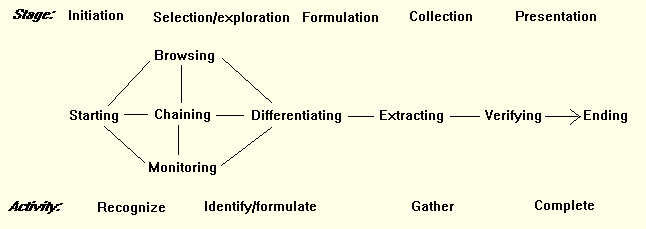
Through this merger of the two models, we can see strong similarities and the major difference appears to be that Ellis specifies the modes of exploration or investigation. The point must be reiterated, however, that Ellis does not present his characteristics as stages but as elements of behaviour that may occur in different sequences with different persons, or with the same person at different times. Thus, the two models are fundamentally opposed in the minds of the authors: Kuhlthau posits stages on the basis of her analysis of behaviour, while Ellis suggests that the sequences of behavioural characteristics may vary.
3.5 Wilson, 1996
Wilson's 1996 [2] model (Figure 7) is a major revision of that of 1981, drawing upon research from a variety of fields other than information science, including decision-making, psychology, innovation, health communication, and consumer research.
The basic framework of the 1981 model persists, in that the person in context remains the focus of information needs, the barriers are represented by intervening variables and information-seeking behaviour is identified. However, there are also changes: the use of the term intervening variables serves to suggest that their impact may be supportive of information use as well as preventive; information-seeking behaviour is shown to consist of more types than previously, where the active search was the focus of attention; information processing and use is shown to be a necessary part of the feedback loop, if information needs are to be satisfied; and three relevant theoretical ideas are presented: stress/coping theory[22], which offers possibilities for explaining why some needs do not invoke information-seeking behaviour; risk/reward theory[23, 24], which may help to explain which sources of information may be used more than others by a given individual; and social learning theory, which embodies the concept of self-efficacy, the idea of 'the conviction that one can successfully execute the behavior required to produce the {desired} outcomes' [25]
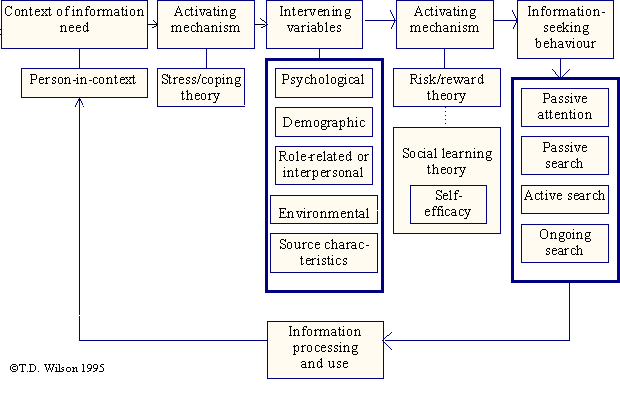
Thus, the model remains one of macro-behaviour, but its expansion and the inclusion of other theoretical models of behaviour makes it a richer source of hypotheses and further research than Wilson's earlier model.
We can also attempt to relate this model to the others discussed above. It is fairly obvious that the models of both Ellis and Kuhlthau relate to the active search mode of information seeking behaviour and provide, in effect, an expansion of that box in the diagram above. Dervin's model is completely different in character, since its aim to provide a framework for exploring the totality of information behaviour from the exploration of the context in which information needs arise to the means whereby that need is satisfied, whether through active searching or otherwise. In effect, it is a model of a methodology, rather than a model of a set of activities or a situation.
4. Summary of the information behaviour models
I have labelled these models information behaviour models because it is clear that they are not information search models in the sense that might be understood by the information retrieval researcher. They are concerned with, on the one hand, generalized behaviours surrounding the actual initiation of information-seeking and, on the other, with a broader perspective of the information search than simply the use of computer-based information retrieval systems. This is an important point to make, since the implications for IR systems from research in the general area of information behaviour may inform the overall design principles of such systems, and may enable the information content developer to specify more clearly what navigational routes are needed through the information and exactly what kind of information or data types need to be in the record, but the specification of rules for the design of interactive systems on the basis information behaviour research may not be possible. Thus, from Wilson's 1996 model we can reasonably hypothesise that an IR system should be designed so as to reduce the risk of failure by the user and, thereby, increase his or her sense of self-efficacy, but the means whereby the risk is reduced must be a matter for the system designer. However, better systems are likely to be designed if the designer understands the ideas of risk/reward and self-efficacy.
Again, Ellis's work suggests that an IR system ought to provide more navigational routes for the user, providing not only Boolean or best-match search strategies, but also the capacity to chain through citations in texts both backwards and forwards in time, and with intelligent agents to monitor additions to the database according to, say, the user's last search or an established profile.
Similarly, given that virtually all studies of information-seeking behaviour show the importance of personal networks, IR systems could well embody routines that would enable users to indicate their willingness to be put in contact with others interested in the same research areas. By doing so, IR systems could become genuine tools for collaborative work, not only within but across disciplines: the potential for this has been made real by the development of the Internet and by modern software tools that allow the 'desk-top' to act as the interface to the Internet and World Wide Web.
5. Information searching models
The relationship between information-seeking behaviour in the general sense and information retrieval behaviour is obviously a close one: the use of IR systems is one possible strategy in the collection of information and, hence, constitutes a potential sub-stage in the information-seeking process.
From the perspective of the interaction of users with IR systems, Saracevic [26] has provided a useful review of the various models of users in interaction with IR systems. Saracevic identifies three models: the 'traditional' model, which '...represents IR as a two prong set (system and user) of elements and processes converging on comparison or matching...'; Ingwersen's cognitive model [27], which '...concentrates on identifying processes of cognition which may occur in all the information processing elements involved.'; and Belkin's 'episode model' [28], which '...considers user interaction with an IR system as a sequence of differing interactions in an episode of information seeking...'. Saracevic then goes on to propose what he calls a 'stratified interaction model' developed within an overall framework of an 'acquisition-cognition-application' model of information use. The levels or strata posited by Saracevic are simplified (in his words) to three: surface, or the level of interaction between the user and the system interface; cognition, or the level of interaction with the texts or their representation; and the situation, or the context that provides the initial problem at hand.
Ingwersen's model is slightly simplified in Figure 8. When we examine this model, we can see its close family resemblance to other models of information seeking behaviour. In particular, the elements user's cognitive space and social/organizational environment, resemble the person in context and environmental factors specified in Wilson's models and the general orientation towards queries posed to an IR system point to a concern with the active search, which is the concern of most information-seeking models. Ingwersen, however, makes explicit a number of other elements: first, he demonstrates that within each area of his model, the functions of the information user, the document author, the intermediary, the interface and the IR system are the result of explicit or implicit cognitive models of the domain of interest at that particular point. Thus, users have models of their work-task or their information need, or their problem or goal, which are usually implicit, but often capable of explication. Again, the IR system is an explication of the system designer's cognitive model of what the system should do and how it should function. Secondly, Ingwersen brings the IR system into the picture, suggesting that a comprehensive model of information-seeking behaviour must include the system that points to the information objects that may be of interest to the enquirer. Thirdly, he shows that various cognitive transformations take place in moving from the life-world in which the user experiences a problem or identifies a goal to a situation in which a store of pointers to information objects can be satisfactorily searched and useful objects identified. Finally he points to the need for these models or cognitive structures and their transformations to be effectively communicated throughout the 'system', which will include the user, the author and the IR system designer.
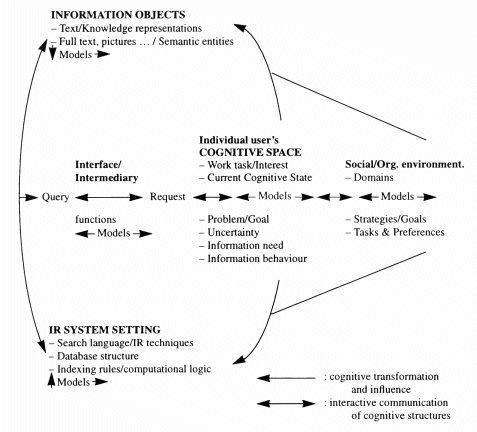
Thus, Ingwersen's model, to a degree, integrates ideas relating to information behaviour and information needs with issues of IR system design, and this, together with the focus on cognitive structures and the idea of polyrepresentation, is an important strength of the model. Saracevic suggests that [26]: 'The weakness is in that it does not provide for testability… and even less for application to evaluation of IR systems.' However, recently, Borlund and Ingwersen[29] have developed and tested an evaluative strategy on the basis of this model and have demonstrated its value in testing interactive IR systems. A potential weakness that remains is that the whole of information behaviour as defined in other models examined in this paper is subsumed under the heading of the user's cognitive space. Issues of how users arrive at the point of making a search, and how their cognitive structures are affected by the processes of deciding how and when to move towards information searching, may be lost. From the point of view of Wilson's 1996 model the significant part of Ingwersen's model (apart from its explicit cognitive theory orientation) is in the description of the active search process and the elements of that process.
Belkin's 'episode' model might be better termed an activity model or interaction model, since its focus is on the actions carried out in an information search, from scanning to searching, within a framework of three other dimensions - goal of interaction (learning-selecting); mode of retrieval (recognition-specification); and resource considered (information- meta-information). According to Belkin, et al. [28]: 'Any single ISS (information-seeking strategy) can be described according to its location along these four dimensions.' However, in the terminology used in this paper, these would be better described as information-searching strategies, since, although couched in terms of a generalised interaction between information-searcher and information-provider, the focus of Belkin's work is on the design of IR systems.
Belkin and his colleagues then advocate the evolution of scripts or plans '…for a dialogue between the user and the rest of the system…Such scripts, based for instance, on, and abstracted from, observations of people as they engage in information seeking, could be used as a means for structured human-computer interaction aimed at achieving the goal of that particular ISS.' While such a goal appears desirable, there may, of course, be significant problems in identifying sufficiently generalised behaviour to produce a limited range of scripts for IR system use. If, however, the underlying rules for script creation from user input could be determined, a more intelligent system might be devised which would create an appropriate script in response to the user's initial interactive behaviour.
Saracevic's own model (Figure 9) is described as a stratified interaction model and posits a (simplified) three level structure: surface, cognitive, and situational.[26] Again, this model shows a strong resemblance to that of Ingwersen. At the surface level, a user interacts with a system through an interface by issuing commands or queries that represent, in some way, a problem statement. At the same level, the system responds either with meta-information, or texts (including images, etc.) or with queries of its own designed to elicit from the user further information on the nature of the problem. At the cognitive level, the user interacts with the output of the system, or with texts obtained subsequent to system interaction, in ways that enable the user to assess the utility of the text in relation to the initial problem. At the situational level, '…users interact with the given situation or problem-at-hand which produced the information need and resulting question. The results of the search may be applied to the resolution or partial resolution of the problem.'
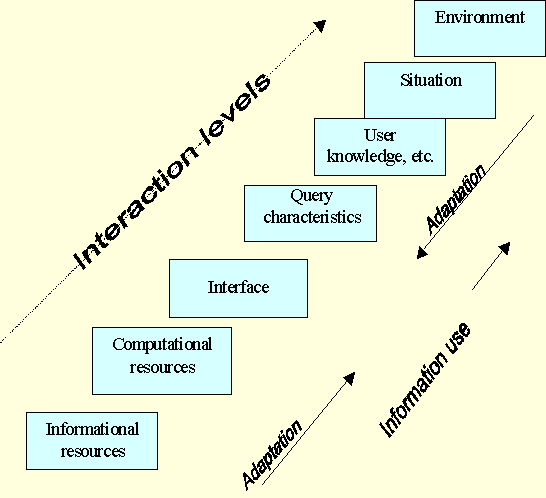
Spink proposes a model of the search process, derived from empirical research, which identifies user judgements, search tactics or moves, interactive feedback loops, and cycles as constituting the search process of a person in interaction with an IR system [30]. The model is shown, in simplified form, in Figure 10 below:
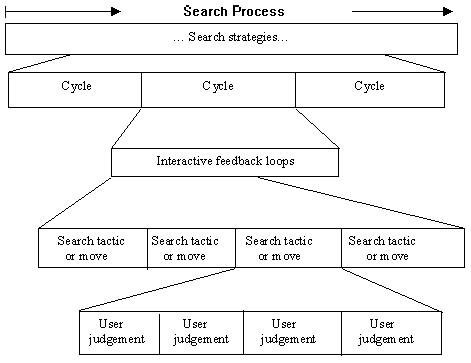
Spink describes the model as follows:
'Each search strategy may consist of one or more cycles {one or more search commands ending in the display of retrieved items...}. Each cycle may consist of one or more interactive feedback occurrences (user input, IR system output, user interpretation and judgement, user input). An input may also represent a move within the search strategy... and may be regarded as a search tactic to further the search.... Each move consists of a user input or query requesting a system's output.' ([30, p.392])
The value of this view of IR interaction is that it is based directly on empirical research and that the appearance of user judgements, search tactics, and interactive feedback loops links IR interaction directly with information-seeking behaviour in general. Thus, judgements made by users must be based upon prior experience gained in the overall activity of information seeking, and tactics and moves may well be derived from behaviour that proves to be useful in settings other than the interactive IR system.
6. Discussion
Models of information behaviour do not all attempt to describe the same set of phenomena or activities: some, as in the case of Ellis[11] are concerned with behavioural patterns in the actual search activity, others, like Kuhlthau[18] present stages of activity, within which the behavioural patterns may occur. The model presented here is of this second type in that it presents problem solving as the overall framework for the activity of information seeking and shows that Kuhlthau's model may fit within the various stages of the information seeking process. We can also suggest that Ellis's behavioural model is a set of activities within what Kuhlthau calls collection and that all three of these are nested within Wilson's 1996 model of information behaviour in general.
This analysis of various models leads me to suggest that the various areas of research within the general field of information behaviour may be seen (as intimated above) as a series of nested fields. Information behaviour may be defined as the more general field of investigation (as shown in Figure 11), with information-seeking behaviour being a sub-set of the field, particularly concerned with the variety of methods people employ to discover and gain access to information resources. Information searching behaviour is then defined as a sub-set of information-seeking, particularly concerned with the interactions between information user (with or without an intermediary) and computer-based information systems, of which information retrieval systems for textual data may be seen as one type.1
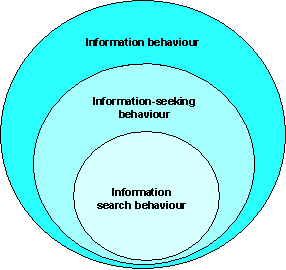
We might also extend the nested model further by showing that information behaviour is a part of human communication behaviour: given the amount of information-related research in various aspects of communication studies, such as that on consumer-behaviour, it may be particularly useful to remember this in certain contexts. There are models in the field of communication theory that are of interest to the information researcher (see, [32] for a review of these) most of which take the Shannon and Weaver ([33]) communication model as their starting point. In particular, the model of Maletzke [34] shows aspects of the communication process that are either included in one or other of the models presented here or could be added to the models to make them more all-inclusive. For example, he suggests that the receiver's (user's) self-image, and 'the receiver as a member of the audience' are aspects to be considered. Maletzke, of course, also details aspects of the 'communicator' that need to be considered in a full elaboration of communication: self-image, personality structure, working team, social environment, organization, and 'pressure and constraints caused by the public character of the media content'.
The focus of studies in information behaviour is on the information seeker of known or unknown communications, while, although the communication recipient is considered in research in communication studies, there is also a strong focus upon the communicator and the channels of communication. So, while attention is drawn to the connection here, Figure 1 does not include communication studies as an all-embracing field. However, we can show the general relationship between communication and information-seeking behaviour as follows (Figure 12):
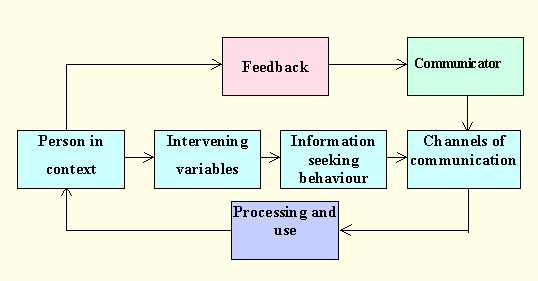
The diagram simplifies Figure 7, renames information sources 'channels of communication', links the basic model to the communicator as the originator of messages over the channels of communication and shows a feedback loop through which the communicator learns of the recipient's response to the communication. Enlarging the original model in this way enables us to link the two fields and may enable us to identify and consider relationships in the information-seeking process that have not had detailed treatment in information science research.
We can also suggest that the areas in Figure 12 interact with the field of human/computer interaction (HCI), as indeed they must and, because HCI is concerned with all aspects of human and computer interaction, including computer-based information retrieval, we can perceive it as a related field that intersects with communication behaviour and its sub-fields.
This nested model may be used by researchers in the various fields to remind themselves that the study of a particular topic needs to be undertaken in the context of the surrounding field: thus, information searching should be explored with an understanding of information seeking and the latter with an understanding of information behaviour in general. We can also argue that research may concern itself with one of these fields, as a central subject for investigation, but also that an investigation could, in fact, explore the relationships across the fields. We can envisage this as taking a slice across the circles to explore the behaviour of a group or an individual in terms of overall information behaviour, information seeking within that broad area, and information searching when the person interacts with computer-based systems.
7. Another model
Given the abundance of models in the field, it may seem unhelpful to introduce another, but this model is intended (although it may not accomplish this) to provide a kind of linking or integration of at least some of the models discussed above. This entire paper was stimulated by reading a paper by Saracevic [35], in which he comments:
'If the IR pioneers did not embrace relevance, but lets {sic} say uncertainty as the basic notion, IR theory, practice, and evaluation would have looked very different.'
It occurred to me that, although the concept has not been used in evaluating IR systems (as Saracevic rightly says), nevertheless, it is, in effect, 'the ghost at the feast' since we may assume that much (perhaps most?) information seeking and retrieval is occasioned by uncertainty. Research in IR evaluation may not have made much of the idea, but, from the perspective of the user, it is always there. In the field of communication theory, also, uncertainty has a place in some writers' work: for example, Newcomb [36] suggests that communication is a 'learned response to strain' (taking us back to the idea of stress as a causal factor) and that we are more likely to find increased communication activity in the form of information seeking, giving and exchange 'under conditions of uncertainty and disequilibrium'.
If we accept this proposition, we will naturally ask, 'What is the cause of the uncertainty?' A generalised answer is, 'a problem': the problem may be more or less recognizable as a problem in the normally understood sense of the word, but something in the individual's life-world, which may be the world of everyday life of the citizen, or the world of work of the scientist, professional worker, or whatever, has led in Schutz & Luckmann's terms [37] to a discrepancy between the typifications applied to the life-world and a phenomenon that, at first sight, cannot be fitted into those typifications. In other words, the individual is faced with a problematic situation.2
The solution of the problem, the resolution of the discrepancy, the advance from uncertainty to certainty (or at least some pragmatic solution of the problem) then becomes a goal of the person and we typify the resulting behaviour as goal-seeking behaviour. We then argue that en route to the goal, the individual moves from uncertainty to increasing certainty and that there are stages in the problem-resolution process that are identifiable and recognisable to the individual. These stages are: problem identification (where the person is asking the question, 'What kind of problem do I have?'), problem definition ('Exactly what is the nature of my problem?'), problem resolution ('How do I find the answer to my problem?') and, potentially, solution statement ('This is the answer to the problem.' or, if a pragmatic, rather than a theoretically-based resolution has been found, 'This is how we are going to deal with the problem.')
Clearly, the transition from problem identification to solution statement is not without difficulty: if it was, there would be no problem, since (as Schutz & Luckmann argue) the issue would be dealt with through the individual's existing typifications of phenomena in the life-world and his/her existing stock of knowledge applicable to those typifications. We hypothesise that, (a) each stage sees the successive resolution of more and more uncertainty, and (b) where uncertainty fails to be resolved at any one stage, it may result in a feedback loop to the previous stage for further resolution. We may represent this as in Figure 13:
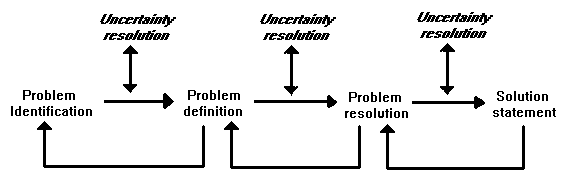
In other words, and for example, failure to find a useful definition of the problem may result in a return to the problem identification stage, for further consideration of the problematic situation, if the uncertainty-resolution loop fails.
The important question at this point is, 'How is uncertainty resolved?' This is where we can bring into the model the previous attempts at modelling information behaviour and, specifically, those of Kuhlthau and of Ellis. One proposition may be that Kuhlthau's 'stages' can be seen not as steps in a single information seeking activity, but reiterated steps that may occur in exploratory loops between each link in the problem resolution chain shown above. The clue to this is Kuhlthau's suggestion that Collection (identified as one of the stages) actually takes place within other stages and it is reasonable to ask, therefore, why collection should be typified as a separate, single stage, when it recurs.
Kuhlthau's model (discussed earlier) has the stages initiation, selection, exploration, formulation, collection, and presentation, which are described more fully above. The model proposed here suggests that some of these terms can be used to identify the stages through which an individual moves to resolve uncertainty: uncertainty - initiation - selection - exploration - formulation - collection formulation/reformulation - resolution. Alternatively, we might use Ellis's behavioural model with its 'features' (starting, browsing, chaining, etc.) as the basis for an in-depth analysis of the reiterated search activities at each phase of the problem-solving process.
The idea that problem solving is the underlying motivation for information searching is supported by Spink & Greisdorf on partial relevance. In an analysis of three studies of information search behaviour Spink and Greisdorf show that the assessment by users of documents as partially relevant correlates highly with variables such as a change in the user's definition of the problem, a change in the user's relevance criteria, and a change in the user's knowledge of the problem. Spink & Greisdorf note that the assumptions of research into IR system use that only the highly relevant items retrieved in a search are valued by users and that categorical scales of relevance can be conflated to binary scales (relevant/non-relevant) without loss of information, are erroneous and need to be addressed by IR researchers.
Given the findings of Spink & Greisdorf, the model of information search behaviour suggested above may provide a sound basis for the development of research ideas.
8. Conclusion
The various models of information behaviour, information-seeking behaviour and information searching represent different aspects of the overall problem: they are complementary, rather than competing, as Figure 4 suggests. The key questions for research, therefore, are:
- to what extent are the different models complete, or reasonably complete representations of the reality they seek to model?
- in what ways are the models complementary; that is, how does knowledge of one level of analysis aid another?
- specifically, in the case of information-searching behaviour; how does knowledge of modes of information-seeking behaviour aid our understanding of the search process, if at all?
Research to answer the last question might best focus on projects that take a view of information searching as a complex process embedded in the broader perspective of information-seeking behaviour, and information behaviour in general, rather than on the micro-level of analysis that is typical of the dominant paradigm of information retrieval research.
Acknowledgements
The ideas presented in this paper have benefited from discussions and comments on drafts from, Dr. David Ellis, Nigel Ford, Dr. Amanda Spink and Prof. Peter Willett, as well as from the suggestions of anonymous reviewers. For whatever problems remain, however, I am entirely responsible.
Notes
Note 1: an anonymous reviewer drew my attention to a similar nested model in Rasmussen et al. [31], which, although not directly related, offers a basis for incorporating information-seeking behaviour within a general model of task performance and analysis.
Note 2: Schutz's notion of typification can be explained by quotation: 'What is newly experienced is already known in the sense that it recalls similar or equal things formerly perceived. But what has been grasped once in its typicality carries with it… a series of typical characteristics still not actually experienced but expected to be potentially experienced.'[38] Thus, once we have experienced any phenomenon we have certain expectations of things we experience as similar - we typify them as belonging to particular categories of our experience of the world. Once I experience a tree, I have certain expectations of anything that occurs in my life-world as being tree-like: it will be rooted in one place, rather than moving; if my first experience has been in the summer-time, a tree-like object will be expected to have leaves, and so on. Similarly, we identify all kinds of events in our life-worlds as being similar to previously experienced events. Schutz makes the connection between relevance and typification, in that those facts or experiences that enable us to identify phenomena as members of a particular object group or sub-set of such a group may be viewed as relevant to the typification of those phenomena.
Appendix: A note on feedback
Not all of the models presented above specifically include feedback ([39]) as an element, but it is clear that feedback loops must exist within all models, since progression towards a goal is hardly ever unproblematic. For example, a person at any of Kuhlthau's stages may have to revisit an earlier stage as a result of problems experienced or new information found and, in Ellis's model, a person engaged in, for example, extracting may, as a result, need to return to chaining or browsing to gather further information. Similarly, in Dervin's model, a person moving from situation to outcome may, as a consequence of finding information, need to review the situation and proceed in a different way towards the outcome.
When feedback is explicitly introduced into models of information behaviour the process can be seen to require a model of the process that views behaviour as iterative, rather than one-off and the idea of successive search activities introduces new research questions.
References:
- Report and proceedings. in Royal Society Conference on Scientific Information. 1948. London: Royal Society, 1948
- Wilson, T.D. and C. Walsh, Information behaviour: an interdisciplinary perspective. Sheffield: University of Sheffield, Department of Information Studies, 1996.
- Wilson, T.D., Information needs and uses: fifty years of progress? In B.C. Vickery, (Ed.). Fifty years of information progress: a Journal of Documentation review. (p. 15-51) London: Aslib, 1994
- Westbrook, L., User needs: a synthesis and analysis of current theories for the practitioner. RQ, 1993. 32: 541-549.
- Paisley, W.J.I., Information needs and uses. Annual Review of Information Science and Technology, 1968. 3: 1-30.
- Dervin, B. and M. Nilan, Information needs and uses. Annual Review of Information Science and Technology, 1986. 25: p. 3-33.
- Wilson, T.D., Information behaviour: an interdisciplinary perspective. Informatoin Processing and Management, 1997. 33(4): p. 551-572.
- Wilson, T.D., On user studies and information needs. Journal of Documentation, 1981. 37(1): p. 3-15.
- Allen, T.J., Managing the flow of technology: technology transfer and the dissemination of technological information within the R & D organization. 1977, Cambridge, MA : MIT Press .
- Dervin, B. An overview of sense-making research: concepts, methods and results to date. in International Communications Association Annual Meeting. 1983. Dallas, Texas.
- Ellis, D., A behavioural approach to information retrieval design. Journal of Documentation, 1989. 46: 318-338.
- Ellis, D., D. Cox, and K. Hall, A comparison of the information seeking patterns of researchers in the physical and social sciences. Journal of Documentation, 1993. 49: 356-369.
- Kuhlthau, C.C., Inside the search process: information seeking from the user's perspective. Journal of the American Society for Information Science, 1991. 42: 361-371.
- Eysenck, H.J., W. Arnold, and R. Meili, Encyclopaedia of psychology. London: Search Press, 1972
- Dervin, B. and P. Dewdney, Neutral questioning: a new approach to the reference interview. RQ, 1986(Summer), 25: 506-513.
- Dervin, B., From the mind's eye of the user: the sense-making qualitative-quantitative methodology. In J.D. Glazier & R.R. Powell, (Eds.). Qualitative research in information management. (pp. 61-84). Englewood, CO: Libraries Unlimited, 1992.
- Ellis, D. and M. Haugan, Modelling the information seeking patterns of engineers and research scientists in an industrial environment. Journal of Documentation, 1997. 53(4): p. 384-403.
- Kuhlthau, C.C., Seeking meaning: a process approach to library and information services. 1994, Norwood, NJ.: Ablex Publishing.
- Kelly, G.A., A theory of personality: the psychology of personal constructs. 1963, New York, NY: Norton
- Kwasnik, B.H., The importance of factors that are not document attributes in the organisation of personal documents. Journal of Documentation, 1991. 47: p. 389-398.
- Kuththau, C.C., The influence of uncertainty on the information seeking behavior of a securities analyst. In P. Vakkari, R. Savolainen, and B. Dervin, (Eds.) Information seeking in context: proceedings of an International Conference on Research in Information Needs, Seeking and Use in Different Contexts, 14-16 August, 1996, Tampere, Finland. London: Taylor Graham, 1997
- Folkman, S., Personal control and stress and coping processes: a theoretical analysis. Journal of Personality and Social Psychology, 1984. 46: 839-852.
- Murray, K.B., A test of services marketing theory: consumer information acquisition activities. Journal of Marketing, 1991. 55: 10-25.
- Settle, R.B. and P. Alreck, Reducing buyers' sense of risk. Marketing Communications, 1989 (January), 14: 34-40.
- Bandura, A., Self efficacy: towards a unifying theory of behavioural change. Psychological Review, 1977, 84: 191-215.
- Saracevic, T. Modeling interaction in information retrieval (IR): a review and proposal. In: Steve Hardin, (Ed.) 59th Annual Meeting of the American Society for Information Science. Silver Spring, MD: American Society for Information Science, 1996. p. 3-9
- Ingwersen, P., Cognitive perspectives of information retrieval interaction. Elements of a cognitive IR theory. Journal of Documentation, 1996. 52, 3-50.
- Belkin, N.J., et al., Cases, scripts and information seeking strategies: on the design of interactive information retrieval systems. Expert Systems with Applications, 1995. 9: 379-395.
- Borlund, P. and P. Ingwersen, The development of a method for the evaluation of interactive information retrieval systems. Journal of Documentation, 1997. 53(3): 225-250.
- Spink, A., Study of interactive feedback during mediated information retrieval. Journal of the American Society for Information Science, 1997. 48(5): 382-394.
- Rasmussen, J., A.M. Pejtersen, and L.P. Goodstein, Cognitive systems engineering. 1994, New York: Wiley. xviii, 378.
- McQuail, D., Mass communication theory: an introduction. (3rd. ed.) 1994, London: Sage.
- Shannon, C.E. and W.W. Weaver, The mathematical theory of communication. 1949, Urbana [Ill.]; London: University of Illinois Press.
- Maletzke, G., Psychologie der Massenkommunikation. Hamburg: Hans Bredow-Institut, 1963.
- Saracevic, T. Relevance reconsidered '96. in: P.E.R. Ingwersen & N.O. Pors, eds. COLIS 2 Second International Conference on Conceptions of Library and Information Science: Integration and Perspective. Copenhagen: Royal School of Librarianship, 1996. p. 201-218
- Newcomb, T., An approach to the study of communication acts. Psychological Review, 1953. 60: 393-404.
- Schutz, A. and T. Luckmann, The structures of the life-world. 1974, London: Heinemann.
- Schutz, A., On phenomenology and social relations: selected writings. Edited and with an introduction by Helmut R. Wagner. 1970, Chicago: University of Chicago Press.
- Spink, A. and R.M. Losee, Feedback in information retrieval. Annual Review of Information Science and Technology, 1996, 31 33-78.
How to cite this paper:
Wilson, T.D. (1999) "Models in information behaviour research" Journal of Documentation, 55(3) 249-270 [Available at http://informationr.net/tdw/publ/papers/1999JDoc.html]